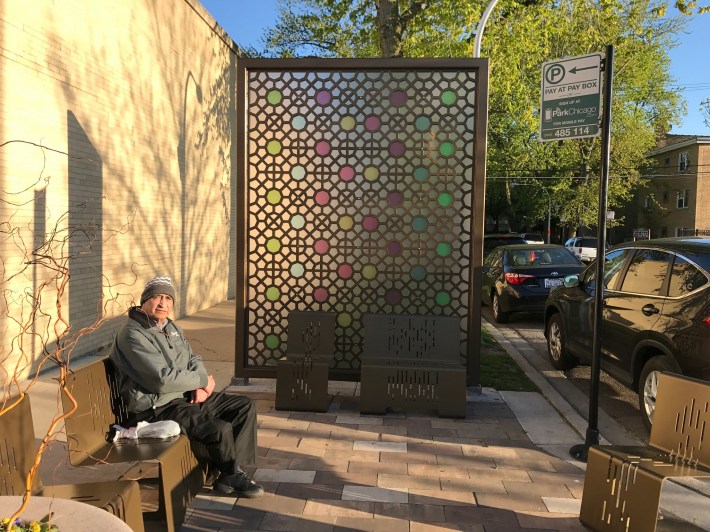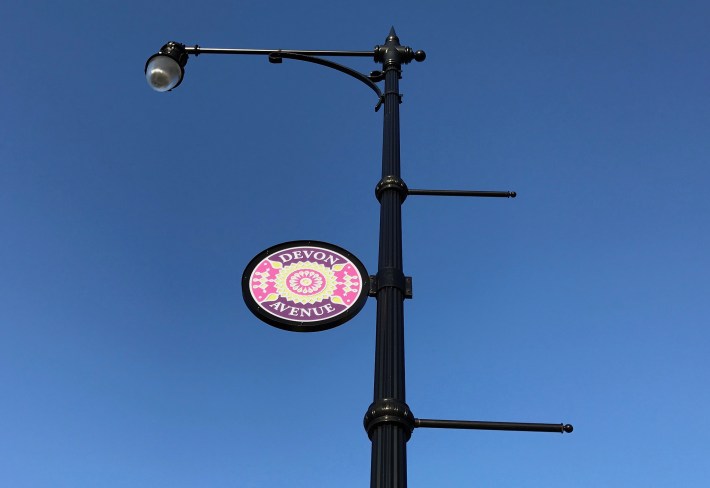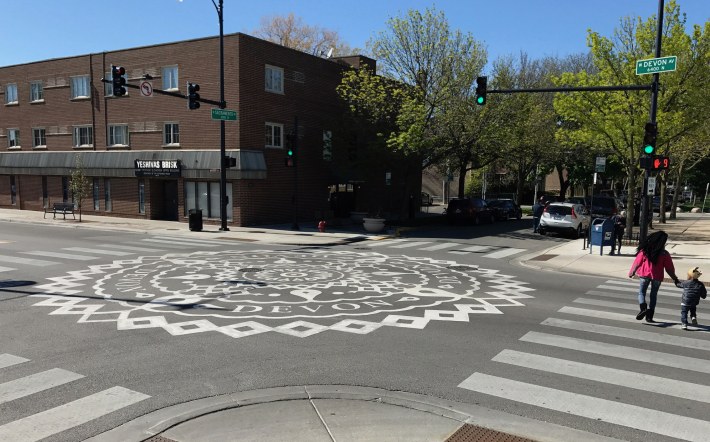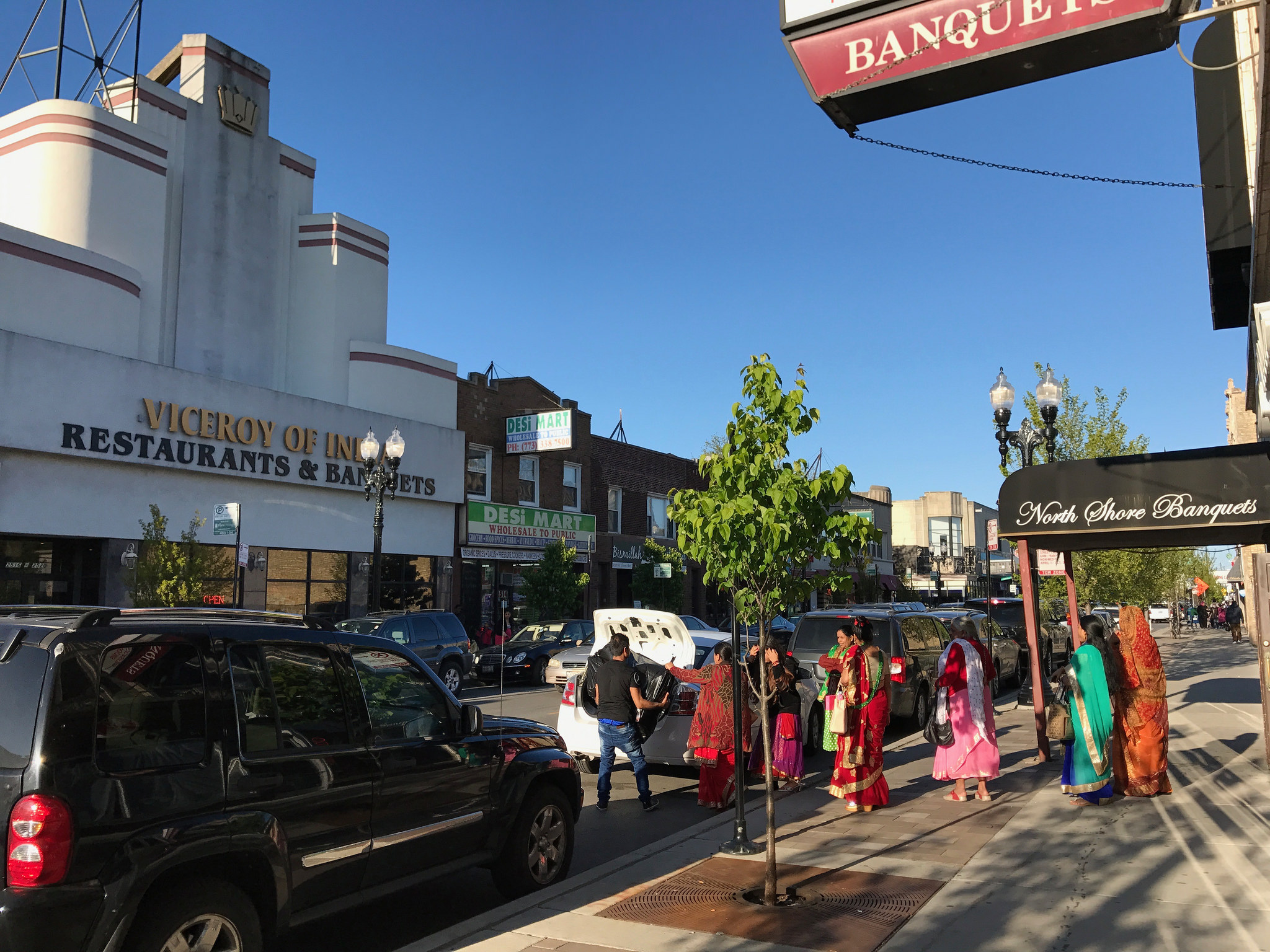[The Chicago Reader publishes a weekly transportation column written by Streetsblog Chicago editor John Greenfield. We syndicate the column on Streetsblog after it comes out online.]
A visit to the Devon Avenue business strip in West Ridge is a kaleidoscopic experience. There’s a swirl of flashy storefronts, iridescent saris, booming bhangra music, and aromas of cumin and kebabs in the Desi (South Asian) part of the district, concentrated between Leavitt and California. Further west you see a mix of Balkan, Orthodox Jewish, and Eastern European establishments, including the Croatian cultural center, a kosher fish market, and the city’s only Georgian bakery. It’s a first-class feast for the senses.
But until recently the corridor provided a less-than-stellar physical environment for walking. One had to jostle with other shoppers on narrow, crumbling sidewalks. Lighting and benches were merely functional, not attractive, and there was a dearth of trees and public art.
That’s changing thanks to an in-progress $15 million streetscape project constructed by the Chicago Department of Transportation that covers the 1.25-mile stretch of Devon from Leavitt to Kedzie. On the central stretch that’s been completed so far, from Western to Sacramento, the revamp has dramatically widened the sidewalks and built curb bump-outs at corners to shorten crossing pedestrian distances. It has also beautified the public way with flower planters, small trees, pavers in the parkways, old-timey “acorn” lampposts (similar to what’s on State Street in the Loop), and “seating pods” on side streets that encourage socializing.

On top of that there are street decorations, chosen with input from locals, that reflect the neighborhood’s ethnic mosaic, with designs inspired by Mughal architecture, Rangoli floor art, and henna tattoos. The final, book-end phases of the revamp, from Levitt to Western and from Sacramento to Kedzie, are slated for completion in late spring 2018.
I dropped by Devon last weekend to find out how folks are interacting with the new built environment. There were plenty of folks strolling past the restaurants, supermarkets, electronics stores, bookshops, jewelry stores, and sweet shops, wearing everything from stylish Western clothes to burkhas.
Earlier in the week 50th Ward alderman Debra Silverstein told me that when she took office in 2011 (after defeating 38-year incumbent Berny Stone) improving Devon’s appearance was a top priority.
“Everyone agreed that we have such a diverse street that we wanted to make it more beautiful and attract more businesses,” she said.
With that in mind, the city selected Tulika Ladsariya, an India-born, Chicago-based artist, to create designs for “community identifiers”—round placards hung from streetlights, “gateway screens” erected behind the seating areas on residential streets to create the feeling of a room, and an “intersection stamp,” a giant, round image painted in the middle of Devon/Sacramento. The latter not only adds visual interest but also helps calm traffic.

“The goal was to have the design be traditional in concept, include all communities, and unite Devon instead of dividing it further,” Ladsariya told me recently. “It is important to understand Hindu, Muslim, even Jewish cultures, and the history of conflict and harmony before aesthetically trying to unite Devon.”
Ladsariya favored “rich jewel tones” in her designs, “to complement the street and not add to the cacophony.” After taking input from community members about what they wanted to see, she presented various alternatives to residents at a charette. “The selection was pretty unanimous,” she says: neighbors favored the purple, pink, and yellow Rangoli-inspired lamppost signs, the henna-influenced intersection stamp, and the seating screens featuring a grid of multicolored octagons, reminiscent of Islamic-Indian architecture and stained glass.
“Many of our customers say Devon looks cozier now,” says Huma Mahtani, co-owner of Resham’s, a shop at 2540 W. Devon that sells Indian dresses and handicrafts. “[The business district] needed a facelift. Now I feel proud of my street.”
Khaleel Farooqi, who grew up just off of Devon and was home visiting from his college in Kentucky, where he studies management information systems, was standing in the sunshine in front of Dulhan’s Bridal Boutique at 2635 W. Devon when I dropped by last Sunday. “I’m just hanging out, having a walk, seeing people, you know?” He said the broader sidewalks encourage this kind of flaneurship. “It’s definitely much more comfortable to walk now.”

Silverstein said she’s also pleased with how things turned out. She appreciates that the new streetlamps feature smaller lights that can change colors to mark the various holidays celebrated along Devon, including Diwali (the Hindu festival of lights), Eid al-Fitr (the end of Ramadan), Christmas, and Hanukkah.
The alderman said the new seating pods also seem to be a hit with residents. “Last night I was driving along Devon and I saw a whole lot of people sitting there enjoying them. So I was like, ‘Wow, that’s really working out.’”
Indeed, when I had visited Devon a few weeks earlier during a warm spell, I saw entire extended families in colorful South Asian clothing chatting in the seating areas. On Sunday it was a little chilly for lounging, but Harsha Gadde, a sharply dressed young IT consultant visiting from Milwaukee, was using one of the multicolored screens as a windbreak while he lit a cigarette. He praised the new streetscape, but argued that Devon needs more car parking. “I think every building needs to have some kind of garage,” he said.
Another local merchant I spoke to, who asked to remain anonymous, says she appreciates that the wider sidewalks and bump-outs make walking easier. But she added that since the parking lane has been moved closer to the center of the street, she feels it creates trickier sight lines for drivers turning onto Devon from alleys and side streets.
“But traffic was bad before, so it doesn’t really make things any worse,” he says. “It does hinder double parking, but people shouldn’t be doing that anyway.” Now that the business district is more pedestrian friendly, Valavanis notes, neighborhood residents will be more likely to walk there instead of driving.
In response to these comments about parking and driving, CDOT spokesman Mike Claffey said that while curbside spots are currently unavailable on some stretches due to construction, there will be no significant long-term loss of spaces, and, due to the better pedestrian environment “parking and walking several blocks to one’s destination will become an enjoyable and safe experience.”
Pete Valavanis, owner of Cary’s Lounge at 2251 W. Devon, says he’s heard complaints that the narrower street makes driving more difficult.
He added that the new street layout was intended to calm traffic on Devon, as well as encourage slower turns by drivers onto the business strip. Between 2010 and 2014 Devon between California and Clark saw 218 injury crashes, including three cases where pedestrian were fatally injured, and in 79 percent of the fatal and serious injury crashes the victims were people walking or biking.
Moreover, Claffey said, the fact that the narrowed travel lanes deter double parking is a feature, not a defect, because “double parking can cause crashes as well as hinder traffic flow.”
As I spoke with Farooqi, the student in front of the bridal boutique, he noted that this is the season for marriages in India, which is why the strip was particularly bustling on that Sunday afternoon. Indeed, as I passed by North Shore Banquet Halls at 2519 W. Devon, a dozen or so women in gorgeous red, gold, and green saris poured out of a wedding reception.
While the new Devon Avenue may be slightly less convenient for drivers, it’s a whole lot safer and more pleasant for people on foot. It’s great that the fashion show that is pedestrian traffic on Devon now has a wider runway.





